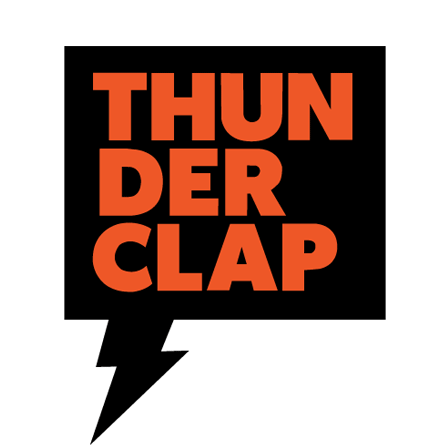You’ve probably heard of crowdfunding before, but what about crowdspeaking?
Enter Thunderclap, an exciting platform authors, entrepreneurs, activists, consumer brands and nonprofits are using to amplify their messages.
Here’s how Thunderclap describes itself:
A tool that lets a message be heard when you and your friends say it together. Think of it as an “online flash mob.” Join a Thunderclap, and you and others will share the same message at the same time, spreading an idea through Facebook, Twitter, and Tumblr that cannot be ignored.”
Thunderclap allows users to create a campaign by writing a message, gather “supporters” to agree to share the message by a certain deadline; on that specified date, the message is blasted out on Facebook, Twitter and Tumblr, leading to massive social reach and amplification.
Best of all? It’s free.
As a communications consultant, I’m always looking for new ways to help my clients share key messages with their desired audiences. When my client and debut author Cara Bradley introduced me to Thunderclap, I jumped at the chance to experiment with using the platform to promote her book.
“As a new author, I know how important it is for me to spread the word about my book, but I’m also very aware and conscious of coming across as overly self-promotional,” Bradley explained. “I was excited to try Thunderclap because it provided an easy and free way for my friends and community to support me and my book launch.”
Want to launch a Thunderclap campaign? Here’s a step-by-step breakdown of how we did it.
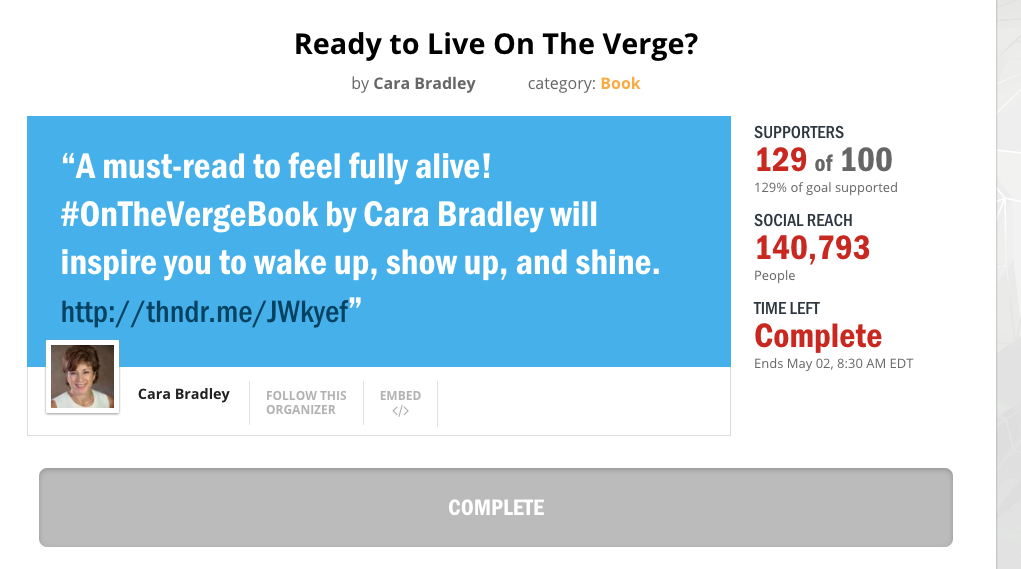
1. Create the campaign
Creating a campaign is easy and intuitive. Create a login and select “Start a Thunderclap.”
You’ll need to fill out information in the following fields:
- Who are you?: Include a short bio here. Thunderclap recommends biographies be one or two sentences, but we copy and pasted Bradley’s 100-word bio with no problem.
- Name your Thunderclap campaign: Be creative! This is what shows up at the very top of your campaign. For Bradley’s, we went with “Ready to Live On The Verge?”
- Category: Choose from a dropdown list of campaign categories. Ours fell under “book” but yours might fall under crowdfunding, cause, film, health, or product and politics, among several others.
- Message: This is the single most important field in the entire campaign, so take your time to think this through. Your message is what supporters agree to share when they back your campaign. Your message can only be 116 characters (not including a link).
Important to note: you cannot include Twitter handles in your message, but hashtags are allowed. - Link: This is the link people will click when your message is amplified. Be sure to link to exactly where you want people to land. Links should not be shortened; Thunderclap will shorten the link for you.
- Choose an end date: Campaigns only last for a specific amount of time. Thunderclap recommends two-to-three weeks, as a shorter timeframe generally creates a sense of urgency, rather than something that drags out for weeks and weeks. Our campaign lasted 17 days, but Bradley reached her goal well before the deadline.
- Supporter goal: Thunderclap allows three different options for a supporter goal: Small (100 supporters), medium (250 supporters) and large (500 supporters) Thunderclap encourages users to be realistic; if you don’t reach your campaign goal, your message will not be shared. We decided to play it safe and aimed for 100 supporters.
- Campaign photo: The campaign photo appears toward the middle of the campaign page. For this book campaign, we used a graphic that included a photo of the book, the title and a brief description.
- Edit your story: Here’s your chance to go a little wild. Tell your story in as many characters as you’d like! Our approach to the story field was to describe the book, as well as share key testimonials for the book from other authors and influencers in Bradley’s industry.
This is what the complete campaign looked like.

Once you finish creating your campaign, you must submit it to Thunderclap for review. They say it takes two or three days, but our campaign was approved almost immediately.
Be ready to take action once your campaign is live!
2. Promote your campaign
Once your campaign is live, you have a limited amount of time to spread the word, so it’s time to get to work.
Here are some of the tactics we used to promote Bradley’s Thunderclap:
Social media:
Naturally, we turned to social media — primarily Facebook and Twitter — to promote the Thunderclap campaign.
On Facebook, we announced the Thunderclap campaign, shared an update on the campaign midway through and published a wrap-up thank you post after the campaign was complete.
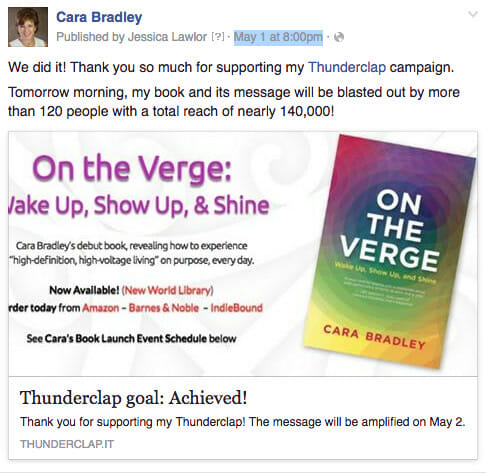
On Twitter, we scheduled several tweets from the launch of the campaign until the very end to keep up the momentum.
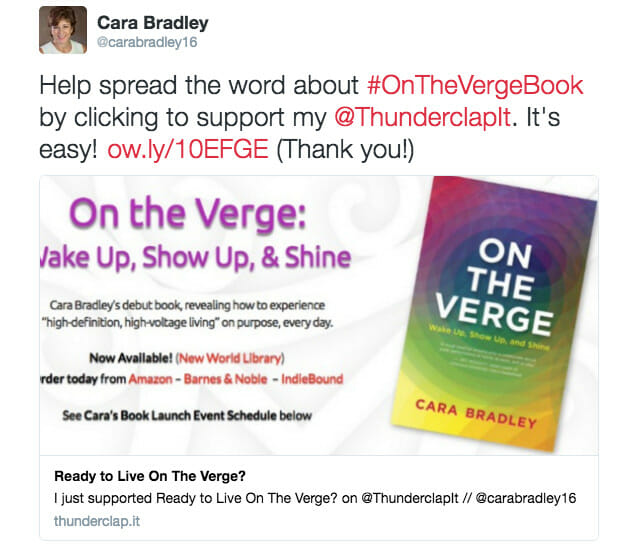
Personal email:
Bradley sent a personal email to her friends, family and book launch team. In the email, she explained what Thunderclap is, talked about her campaign and asked for their support.
Here’s sample text you can use in your own campaign:
I’m writing today to ask one more favor and promise, this task takes less than one minute to complete. It’s to help me spread the word about my Thunderclap to promote the book.
Thunderclap is a really neat social crowd-speaking platform that helps people be heard by saying something together. It allows a single message to be mass-shared, flash mob-style, so it rises above the noise of your social networks. By boosting the signal at the same time, Thunderclap helps a single person create action and change like never before.
My goal is to get 100 people to agree to share the below message about my book by X DATE (we’re at Y so far). When I hit 100, on X DATE, that message will be blasted out to all those who agreed to share, spreading my message even farther and wider than I could ever imagine.
It’s SUPER easy to participate- click THIS LINK and then click “support with Facebook” or “support with Twitter” and voila! That’s it.
It was most crucial for us to stress how easy supporting Bradley’s Thunderclap would be. We made sure to tell her community it would take less than one minute to complete.
This email was the single most important promotion tactic we used; your close friends, family and network are the most likely group to want to share their support, so leverage those relationships and don’t be afraid to ask for their help with the campaign.
Bradley’s been building her email list for quite some time, so when it came time to promote the Thunderclap campaign, we turned to her email community for support.
Thunderclap was included as a message in two of Bradley’s weekly emails in April.
In the first email, we created a section to explain Thunderclap, similar to the above messaging. In the second email, Bradley had already reached her goal on Thunderclap, but we still wanted to grow her reach, so we included messaging in the “P.S.” section of her email to thank people for adding their support and to give an update on the campaign.

3. Prepare website for campaign launch day
Because the Thunderclap campaign linked back to Bradley’s book landing page, we expected an increase in traffic to her site on the morning the campaign launched.
To leverage the new eyes visiting the website, we made it a priority to do a quick review to make sure:
- The book was prominently featured on the homepage of the website
- The book landing page was up-to-date, clean and easy to navigate
- It was easy to find links to purchase the book
- Calls-to-action to join her email list were clear
Results
Bradley’s campaign ended on May 2 with 129 out of the target 100 supports — and a total social reach of 140,793. Goal exceeded!
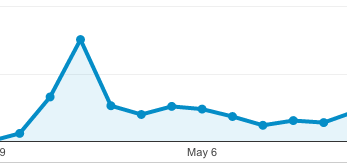
Website traffic tripled on May 2 with 68 percent of traffic that day coming from social (i.e. social shares from Thunderclap). Fifty percent of pageviews that day were to the book landing page and Bradley welcomed a handful of new email subscribers that day, as well.
Most importantly, the message of Bradley’s book was blasted out by more than 120 people with a total reach of more than 140,000. Those who are active on social media know that the long game is more important than short-term wins, and Bradley’s name and book being shared by so many on Facebook, Twitter and Tumbler helps introduce her message to a brand new audience.
Overall, creating, launching and promoting a Thunderclap campaign took less than three hours, yet created massive buzz and increased interest in Cara and her book.
What do you think of this method of attracting social momentum? Would you try it for your own book or product release?







